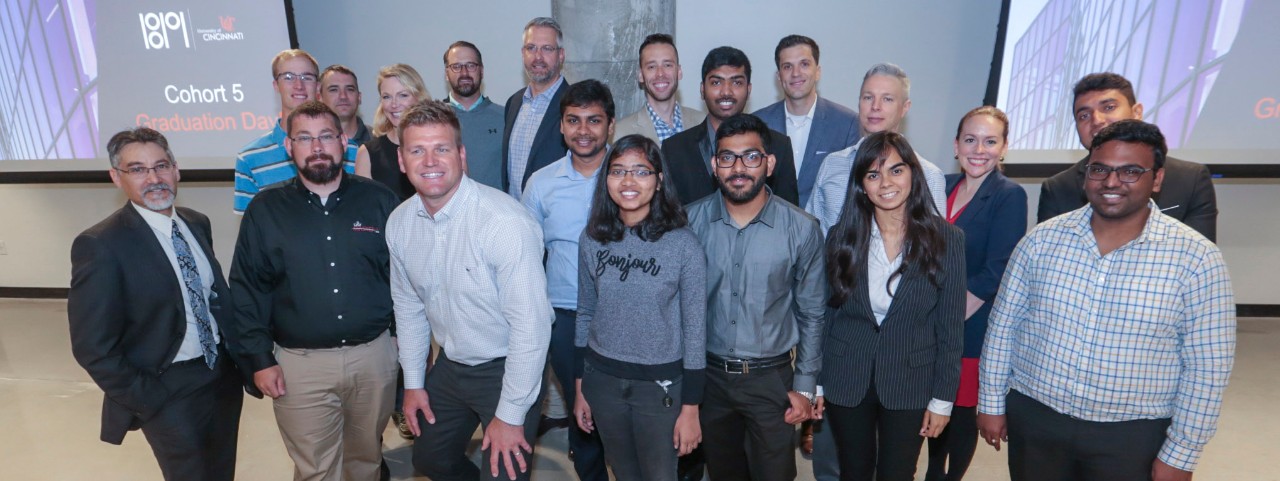
UC Venture Lab graduates its fifth class, celebrates first anniversary
The latest grads from the business pre-accelerator program at the University of Cincinnati’s 1819 Innovation Hub focus on saving lives
The University of Cincinnati Venture Lab pre-accelerator program at the 1819 Innovation Hub celebrated its first anniversary by graduating its fifth group of entrepreneurs on Tuesday, June 18. UC Director of Startups Grant Hoffman is thrilled with how far the program has come in its first year.
“We’re now seeing a constant interest in the program and not having issues filling the classes,” Hoffman said. “We’re learning a little and tweaking it every time, but the amount of interest has continued to grow.”
The Venture Lab and the 1819 Innovation Hub are both under the purview of the UC Office of Innovation. The university’s innovation agenda is a key component of Next Lives Here, UC’s strategic direction.

UC Director of Startups Grant Hoffman
Of the 171 applicants that applied in its first year, 44 were accepted and 40 graduated. Eight of the 14 teams that have come back to ask for first-step funding have received a total of $1.9 million in awards. Six startups launched during Year 1, a marked increase over prior years.
The program’s sixth cohort will launch Aug. 6. UC students, staff, faculty and alumni have until July 19 to apply.
“What we find is that people who have an idea but hide it and don’t talk about it because they don’t know where to get feedback from — that idea rarely goes somewhere,” Hoffman said. “We tell people to come to us and let us be your filter for when you have a good idea and when you don’t.”

Troy Evans, right, presents SideHustle at the Venture Lab graduation ceremony Tuesday, June 18. Photo/Joseph Fuqua II/UC Creative Services
Two of the fifth Venture Lab cohort’s businesses hit the ground running Tuesday.
Binder, a cloud-based for information technology firms to keep documentation of customer issues, uses machine learning to minimize manual data entry. The team of CEO Gex Williams and COO Brian Crone — the latter a UC graduate student — announced that a beta test of their solution launched that day.
SideHustle, a gig-economy app, is already working with early adapters in several market segments. It allows small business owners to identify and connect with workers using psychographics, allowing businesses the opportunity to pursue untapped sales channels via the gig economy. Notably, the SideHustle team includes former UC linebacker and four-year letterman Troy Evans, who went on to play for a decade in the NFL.

The AmbiFly team fields questions from the audience. Photo/Joseph Fuqua II/UC Creative Services
Two teams focused on using drones to save lives. S2UAS is developing tethered drones that can stay afloat far longer than a typical drone while providing WiFi or LTE service to areas affected by natural disasters such as hurricanes and tornadoes. The business wants to address the loss of life that can result from breakdowns in communication networks. The other, a student-led team called AmbiFly, is developing drones that can develop emergency equipment, such as AEDs, Narcan, EpiPens and first-aid kits, to emergency calls that first responders can’t quickly reach because of traffic congestion.
“We did everything we could,” is a phrase UC cardiologist Dr. David Harris never wants to use again. His business, Synchronize, is a technology solution that coordinates medical treatment among code team members — hospital employees that respond to code alerts. Mounted to a crash cart, the software will provide real-time prompts that are informed by the medical records and monitors of individual patients. Harris says there’s nothing like it on the market, and is in search of help with customer discovery and market strategy.
Other presentations included:
Tongue Parts — Gamifying sonographic imaging to help children overcome speech impediments
JAF Innovations — The husband-wife team of UC neurosurgeon Dr. Jonathan Forbes and Julie Forbes are working on a method to use cyanoacrylate glue to seal holes in the cranium left behind after brain surgery
AcouFlow — An alternative to CPAP technology for sleep apnea sufferers
Krian — Real-time analysis of football plays.
Featured Image: The graduates of the most recent Venture Lab class pose for a group photo at the 1819 Innovation Hub. Photo/Joseph Fuqua II/UC Creative Services
Next Lives Here
The innovation agenda is one of three central platforms tied to the University of Cincinnati’s mission. In combination with academic excellence and urban impact, the innovation agenda activates the university’s strategic direction, Next Lives Here. Specifically, it enables our ambition through these identified pathways:
Co-op 2.0 – re-envisioning all aspects of experience-based learning
1819 Innovation Hub – where industry meets university
Inclusive excellence – amplifying our impact
Related Stories
Study finds police officers face higher long-term health risks
January 2, 2026
J.C. Barnes, a University of Cincinnati professor, is interviewed by Spectrum News about new research showing that the physical and psychological demands of law enforcement can contribute to earlier deaths.
Bazinga! UC physicist cracks ‘Big Bang Theory’ problem
December 19, 2025
A physicist at the University of Cincinnati and his colleagues figured out something two of America’s most famous fictional physicists couldn’t: theoretically how to produce subatomic particles called axions in fusion reactors.
